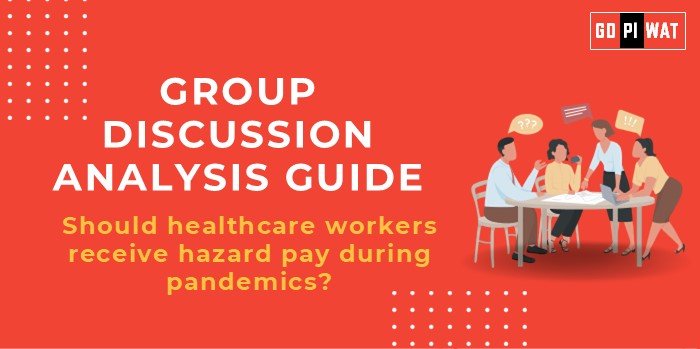📋 Group Discussion (GD) Analysis Guide
🌐 Topic: Should healthcare workers receive hazard pay during pandemics?
🩺 Introduction to the Topic
Opening Context: “Healthcare workers are the backbone of any nation during a pandemic, risking their lives daily to save others. This discussion evaluates whether hazard pay is a justified recognition of their sacrifices and contributions.”
Topic Background: Hazard pay refers to additional compensation for work involving physical hardship or life-threatening risks. The COVID-19 pandemic highlighted the critical role of healthcare workers, sparking debates globally about fair compensation for their heightened risks.
📊 Quick Facts and Key Statistics
- Global Fatalities: Over 115,000 healthcare workers reportedly died during COVID-19, emphasizing their vulnerability.
- Financial Strain: Many countries, like the U.S. and India, introduced temporary hazard pay programs, ranging from $250-$2,500 per month.
- Burnout Rates: 60% of healthcare workers report burnout during pandemics, indicating the toll on mental health.
- Policy Disparity: Only 15% of nations have permanent hazard pay policies for healthcare workers.
🤝 Stakeholders and Their Roles
- Government Agencies: Policy implementation and budget allocation for hazard pay.
- Private Hospitals: Setting compensation standards and supporting healthcare staff.
- Healthcare Workers and Unions: Advocating for fair compensation and improved work conditions.
- General Public: Supporting policies that reward healthcare workers’ sacrifices.
✨ Achievements and Challenges
Achievements
- Recognition of Risks: Governments like Canada and Australia implemented hazard pay during COVID-19.
- Retention: Hazard pay helped retain essential healthcare workers during crises.
- Moral Boost: Financial incentives elevated morale among exhausted workers.
Challenges
- Economic Strain: Budget limitations in developing nations hinder consistent hazard pay.
- Equity Concerns: Variability in hazard pay across regions and institutions.
- Sustainability: Hazard pay schemes are often temporary and lack long-term policy frameworks.
Global Comparisons
- Canada: Provincial governments provided up to CAD 4/hour as hazard pay during COVID-19.
- India: Frontline workers received compensation packages, but disparities existed across states.
🔍 Structured Arguments for Discussion
- Supporting Stance: “Hazard pay is a vital acknowledgment of healthcare workers’ sacrifices, ensuring their financial security during high-risk scenarios.”
- Opposing Stance: “While important, hazard pay may divert critical funds from healthcare infrastructure upgrades during pandemics.”
- Balanced Perspective: “Hazard pay is necessary to some extent, but should be complemented by improved safety protocols and permanent welfare benefits.”
🗨️ Effective Discussion Approaches
- Opening Approaches:
- Statistical Impact: “Over 60% of healthcare workers experienced burnout during COVID-19, underscoring the need for financial and emotional support.”
- Case Study Opening: “India’s frontline workers faced pay delays during COVID-19, leading to unrest and highlighting the need for structured policies.”
- Counter-Argument Handling:
- Acknowledge constraints like budget and equity.
- Highlight benefits such as retention and morale.
- Propose sustainable alternatives like tiered hazard pay systems.
📈 Strategic Analysis of Strengths and Weaknesses
- Strengths: Recognizes risks, improves retention.
- Weaknesses: Budgetary strain, inequity in implementation.
- Opportunities: Global best practices, long-term policy frameworks.
- Threats: Economic challenges, lack of political will.
📚 Connecting with B-School Applications
- Real-World Applications: Case studies on HR policies during crises or resource allocation in healthcare management.
- Sample Questions:
- “How should governments balance hazard pay with broader healthcare investments?”
- “What are the pros and cons of institutionalizing hazard pay policies?”
- Insights for B-School Students:
- Highlighting risk management strategies in operations.
- Understanding the economic and social implications of healthcare policies.


